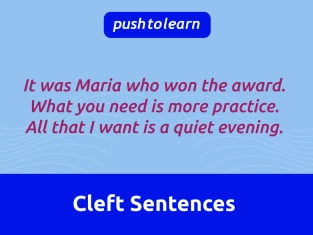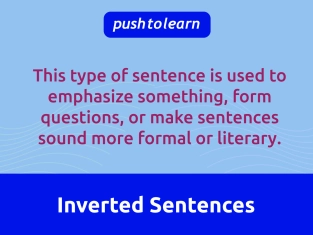by PushtoLearn
Participle Clauses
Table of Contents
Participle Clauses Exercises
These exercises focus on Participle Clauses
What Are Participle Clauses?
Participle clauses are a way to make sentences shorter by using participles instead of full clauses. They are often used in English to sound more formal or concise. A participle clause can give information about time, reason, condition, or result.
Types of Participles
There are three main forms of participles used in participle clauses:
-
Present participle (-ing form)
Example: running, eating, studying -
Past participle (-ed form or irregular third column)
Example: closed, written, built -
Perfect participle (having + past participle)
Example: having finished, having seen

Rules for Using Participle Clauses
1. Present Participle (-ing)
This form shows that two actions happen at the same time or that one action causes another.
Structure:
Subject + participle clause (-ing) + main clause
Examples:
-
Walking to school, she met an old friend. (She was walking, and she met a friend.)
-
Feeling tired, he went to bed early. (He felt tired, so he went to bed.)
2. Perfect Participle (Having + Past Participle)
This form shows that one action was completed before another.
Structure:
Having + past participle, main clause
Examples:
-
Having finished his homework, he watched TV. (He finished homework first, then watched TV.)
-
Having been warned about the storm, they stayed indoors. (They were warned first, then stayed inside.)
3. Past Participle (-ed or Third Column)
This form often describes passive actions or completed actions.
Structure:
Past participle, main clause
Examples:
-
Built in 1900, the house still looks beautiful. (The house was built in 1900.)
-
Exhausted by the long hike, they rested for hours. (They were exhausted, so they rested.)
4. Used After Prepositions or Conjunctions
Participle clauses can also come after words like after, while, before, since, or when.
Examples:
-
After finishing her meal, she left. (She left after she finished her meal.)
-
While working on the project, he learned a lot. (He learned a lot while he was working.)
Common Errors in Participle Clauses
|
Error |
Explanation |
Corrected Version |
|
Walking to school, the rain started. |
The subject is unclear (Who was walking?). |
Walking to school, she got caught in the rain. |
|
Having eaten breakfast, the bus arrived. |
The participle refers to the wrong subject (The bus didn’t eat!). |
Having eaten breakfast, he waited for the bus. |
|
Built in 1900, people love the house. |
The subject of the participle is unclear (People weren’t built in 1900!). |
Built in 1900, the house is loved by many people. |
Everyday Use of Participle Clauses
Participle clauses are common in both spoken and written English, especially in:
-
News headlines:
Found guilty, the suspect awaits sentencing. -
Instructions or manuals:
Pressing the button, you will start the machine. -
Storytelling:
Running out of time, they decided to call for help.
FAQ on Participle Clauses
What is a participle clause?
A participle clause is a shortened form of a sentence using participles to make it more concise.
When do we use participle clauses?
We use them to show actions happening at the same time, completed actions, or reasons for something.
What’s the difference between -ing and -ed participle clauses?
-
-ing participles show active actions or simultaneous events.
-
-ed participles show passive or completed actions.
How do I avoid mistakes with participle clauses?
Make sure the subject of the participle clause matches the subject of the main sentence.
Can participle clauses be used in informal English?
Yes, but they are more common in formal or written English, such as articles or reports.

